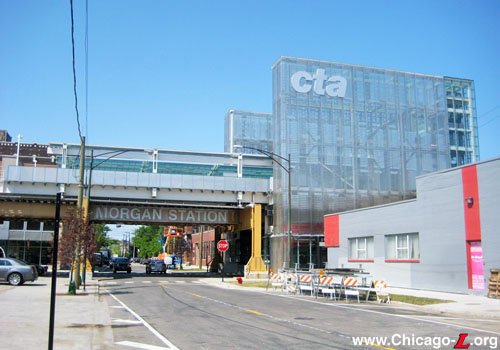
Morgan station is seen looking north on the station's opening day, May 18, 2012. The two 4-story 40-foot tall towers on either side of the "L" structure, sheathed in glass and panels of perforated stainless steel with large CTA logotypes at the top, are distinctive features of the station. For a larger view, click here. (Photo by Graham Garfield) |
Morgan
(1000W/200N)
Morgan Street and Lake
Street, Near West Side
Service
Notes:

|
Green Line:
Lake |

|
Pink Line:
Lake |

|
Accessible
Station |
Quick Facts:
Address: 958 W. Lake Street
|
Established:.
|
November 6, 1893 (original station opened)
|
|
April 4, 1948
(original station closed)
|
| May 18, 2012 (current station
opened) |
Original Line: Lake Street Elevated Railroad
Previous Names: none
Skip-Stop Type: n/a
Rebuilt: 2010-12
Status: In Use
History:
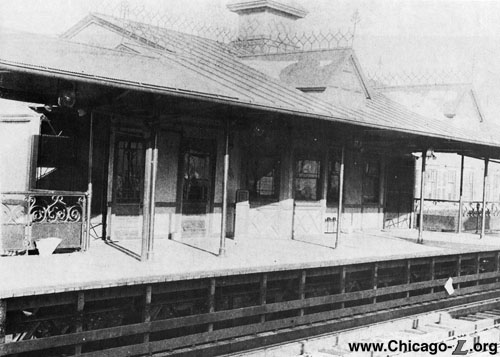
This view shows the platform of a typical
Lake Street "L" station -- of which Morgan was one -- in 1892. Note the decorative
railings on the left and the characteristic roof adornments. For a larger view, click here. (Photo from the Krambles-Peterson
Archive) |
Morgan station was typical of those built in 1892-93 for the Lake
Street Elevated Railroad -- similar to stations at Ashland,
Homan and Sacramento,
among many others -- designed by its engineering staff and built by
the Lloyd and Penning ton Company.
The station had twin station houses and side platforms for
boarding inbound and outbound trains. The station houses are designed
in a Queen Anne style with a Victorian Gothic influence. The station
houses had gabled roofs with two windowless gabled dormers each. Each
roof was topped with a unique square cupola with a diamond pattern
and a steeply hipped roof with a small gabled dormer in each of the
four sides. These structures represent a unique attempt to apply the
Queen Anne architectural style.
The station had side platforms, covered by tin-covered peaked-roof
canopies supported by a row of steel center posts. The posts had
decorative elements cast into them, most notably in the top angle
bracket that supported the canopy braces. The Lake Street Elevated
stations also originally had elaborate railings on the platforms with
decorative scroll metalwork.
The station was closed in 1948 when the
CTA revamped service on the Lake Street Line -- the
first of a series of line-by-line service overhauls -- by closing 10
little-used stations and implementing A/B
skip-stop service to speed up trains on the route. The station, along with Racine, Damen, Oakley, Campbell, Sacramento, and Kostner,
was demolished in early 1949. Prior to the start of wrecking work, all usable equipment, such as newer lumber, doors, and newer railings were removed for reuse elsewhere. Platform girders from the dismantled stations were reused to lengthen platforms at other "L" stations.
A New Morgan Station Returns
When the Green Line
was closed for renovation in 1994-96, a plan was developed to close
Halsted station two blocks east
permanently and build a new station at Morgan to service the
redeveloping Fulton Market district. A station nearly identical to
the rebuilt Laramie station was
developed by Skidmore,
Owings & Merrill (SOM). Halsted
station closed in 1994 at the outset of the renovation (which included a full closure of the Green Line for two years), but during the closure the plans to build the Morgan station were put on hold due to budget limitations for the project and a desire to shift resources to other aspects of the project, such as adding a station at Laramie where none was originally planned to be rebuilt. Periodic
discussions among the city,
CTA, and community of
reestablishing a station at Morgan continued for many years.
Planning, Funding, and Contracting for a New Station
|
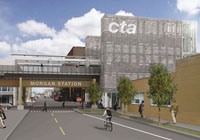
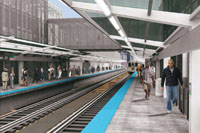
Artist's renderings of the Morgan station show the facility looking north on Morgan Street, with the station's steel-panelled elevator and stair enclosures providing a strong and distinctive profile (top) and the platforms, including the concrete deck, cantilevered canopies with translucent roofs, raceway with station name signs, and transfer bridge overhead (above). For a larger view of the top image, click here. For a larger view of the above image, click here. (Rendering courtesy of CDOT) |
A 2002 study by the Chicago Department of Transportation examined daily boarding at potential new "in-fill" stations on the Lake Street and South Side main line Green Line branches, including Morgan on the Lake Street branch. The feasibility study found good potential for ridership for stations at both Western and Morgan on the Green Line, but CDOT -- who managed the study, design, and construction of the station -- decided to move forward with the Morgan station based on a number of factors. CDOT spokesman Brian Steele cited that since the study, which used 2000 census figures, the area around the Morgan station saw significant residential and commercial growth, much more than the area around Western. The 2006 addition of Pink Line service through the corridor that would be served by a Morgan station, strong community and business support, and availability of TIF dollars were also factors that influenced the decision to build at Morgan as opposed to other locations.1
The project was managed by the Chicago Department of Transportation (CDOT) and cost $38 million. The city secured $8 million in federal funds through the Congestion Mitigation and Air Quality program, with the rest coming from the Kinzie Industrial Tax Increment Financing District2.
The new station was planned to serve several area businesses, institutions, and residents, including Harpo Studios, where the Oprah Winfrey Show was taped and which has audiences of up to 1,000 people a day in addition to many full- and part-time employees (though the Oprah Winfrey Show actually ended its run in 2011, other shows used the studio as well until its closure in 2015; the site was subsquently home to the new global headquarters of McDonald's); the Haymarket Center social service agency, with 500 employees and 18,000 clients; the many high-end restaurants, bars, and lofts in the area; and the industries and businesses in the Fulton industrial corridor.
On June 8, 2011, the Chicago Transit Board officially named the new station "Morgan" by ordinance, at the same time setting the name for the new Oakton-Skokie station opening around the same time as Morgan and renaming Skokie station to be ""Dempster-Skokie" upon Oakton's opening. Costs for creating station signs for the new Oakton-Skokie and Morgan stations were funded by capital grants obtained to build the stations; station signage, system maps, and announcements were updated to reflect the changes when those projects are completed.
Station Design
Design for the Morgan station was carried out by TranSystems and Ross Barney Architects, who performed engineering and architectural services, respectively. The station has two entrances -- one on each side of Lake Street -- bike racks, Customer Assistant kiosks, security cameras, and a six-car length translucent canopy. Early concepts also had a concession stand3, but this was not included in the final station as opened. The station has dual elevator towers and an overhead transfer bridge.
The designers viewed the Morgan station project as "a unique opportunity, in the historic Fulton Market District, to define the geographic center and the character of an industrial loft area that is transforming into a multi-faceted neighborhood." The material finishes for the station were "developed by looking at the surrounding context and character of the neighborhood. The new construction and residential growth have provided a wonderful contemporary environment against which the station will be located."4
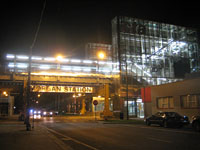
The Morgan station was designed with decorative lighting that would highlight its architectural features including the perforated steel panels on the dual towers, as seen on the evening of September 15, 2012. For a larger view, click here. (Photo by Graham Garfield) |
The designers made the challenge of a tight site along the Lake Street "L" line a virtue -- a conventional mezzanine under the tracks over the street where passengers would climb and pay fares before ascending to the platforms, was ruled out because it would have obstructed truck traffic.5 The designers also decided not to place the fare controls at platform level on one side and have passengers needing to access the opposite platform do so by way of a transfer bridge, as Skidmore's unbuilt design would've done.
Instead, Ross Barney Architects, led by principal Carol Ross Barney and lead project architect Ryan Giblin, stacked the fare control, platform access and transfer bridge access elements vertically, creating the station's signature -- and most visible -- elements: two 4-story 40-foot tall towers on either side of the "L" structure. Sheathed in glass and panels of perforated stainless steel, each tower contains a ground-level station house, stairs between the station house and a platform, stairs between a platform and the transfer bridge, and an elevator connecting all three levels.
Rather than attempt to mimic the muscular brick structures of nearby lofts and warehouses, the boxy tower slabs, according to Chicago Tribune architecture critic Blair Kamin, have the right toughness for the neighborhood, yet by virtue of their height, transparency and glinting presence, they give it something fresh. Computer-etched patterns on the perforated steel panels -- resembling the ladder-like pattern of railroad tracks -- suggest the shadows cast by the elevated structure on the street below.6 Large-scale stainless steel "cta" logotypes are mounted on the sides of the towers, making the station easy to identify from afar.
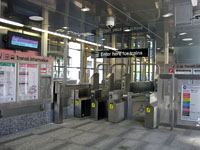
The interior of the inbound station house at Morgan is seen looking northeast on opening day, May 18, 2012. The station interior is compact, but features static and digital information displays as well as farecard vending (out of view). For a larger view, click here. (Photo by Graham Garfield) |
The station houses, forming the base of the towers, are located on the northeast and southeast corners of Lake and Morgan streets. The entrance facilities have a concrete base and watertable on three sides, raising to a higher wall a few feet tall on the Lake Street elevation of each enclosure to protect it from wayward cars and trucks. A dedication plaque is inset into the concrete base on the west elevation of the south station house. The facilities are enclosed in glass curtain walls, with metal anchors and rubber gaskets between the panels to keep the walls light and transparent, above which the metal sheathing that covers the rest of the towers begins. Only the portions of the exterior walls that have farecard vending machines against them inside are solid, clad in metal panels.
Inside, the station houses are open and transparent, if not generous in proportion with relatively limited space and somewhat low ceilings. The two station houses are nearly identical, their floorplans simply being mirror-reversed. The floors are made of medium gray granite panels, alternated with narrow panels of darker gray granite. The concrete base along the bottom of the walls is faced with granite inside, with the higher wall along Lake Street faced in stainless steel above the granite. The glass walls allow a lot of natural light in (at least as much as it allowed through the elevated track structure and between the adjacent buildings), while a polished steel suspended ceiling not only helps reflect both the daylight and illumination from the light inset inside it but also contributes to the light., airy atmosphere. A few farecard vending machines are provided on the west wall of each interior, while a Customer Assistant booth is provided in the interior corner closest to the street intersection. However, when the station opened only the booth in the south (inbound) station house was staffed. The booths are spacious (by CA booth standards), faced in stainless steel with a band of windows on all four sides for maximum visibility. Sliding doors on the east face of the booth allow easy communication between the staff and passengers. The booth's walls extend all the way to the ceiling. Two standard turnstiles and one accessible turnstile are provided in each entrance, which are also outfitted with a Transit Information Panel in the unpaid and paid areas and digital train arrival signs. In the paid area, the circulation path narrows to get around the stairs rising to the platform, which customers access from the rear area of the station house. The elevator to the platform and transfer bridge is in the back of the station house, behind the stairs.
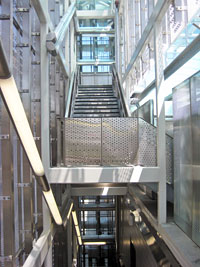
A view inside the north tower at Morgan station on May 18, 2012 reveals the interesting lines, angles, and shapes within, including patterns caused by light filtering through the perforated metal wall panels. The stairs below lead to the station house, while those above lead to the transfer bridge. For a larger view, click here. (Photo by Graham Garfield) |
The stairs between the station house and the platform, and between the platform and the transfer bridge, are stacked above one another within the same towers as the elevators, creating what architecture critic Blair Kamin called, "tall shafts of sky-lighted space, enlivened by structural columns and beams, stair railings and other features, even drain pipes, organized in a precisely honed machine aesthetic."7 Tying all the elements together, a rounded, horizontal band of florescent lights runs from the station house to the sky bridge.
Materials on the platform level were chosen to permit visibility through the station and reinforce the feeling of openness.8 The station features dual 425-foot-long side platforms extending from west of Morgan Street to east of Sangamon Street. The platforms have precast concrete decks, the first use of precast concrete in a CTA "L" station (previous concrete decks have been poured-in-place). Each platform has a canopy over 320 feet long,9 covering the each platform for most of its length. Each canopy is designed with a flat, angled roof cantilevered from a row of white-painted I-beam support columns along the back of the platform. The canopy roofs use a soft, sage-green-tinted translucent polycarbonate, which not only provide weather protection but also daylighting. The canopies were engineered and fabricated by Duo-Gard Industries Inc., makers of translucent technology for custom architectural canopies and daylighting systems "The station's translucent canopies are a predominant part of the design," said Giblin. "The translucent polycarbonate glazing lets in a lot of diffused daylight, plus the material is durable and easily maintained." Giblin said the six-wall, 20mm-thick polycarbonate, virtually shatterproof, has the advantage of being much lighter in weight than glass, significantly reducing the need for structural support. He also cited the system's ease of maintenance and sustainability -- the polycarbonate contributes to this with recycled content, and it's completely recyclable.10
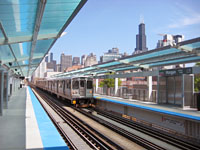
An Ashland/63rd-bound Green Line train of 2400-series cars departs the new Morgan station platform on opening day, May 18, 2012, while the impressive Loop skyline looms over the green-tinted translucent polycarbonate canopy roof. For a larger view, click here. (Photo by Graham Garfield) |
The platform railings, like those on the stairs, have a polished stainless steel frame with metal panels perforated with a pattern of alternating circles. Along the top of the canopy support columns, under the roof, is a horizontal raceway enclosure housing electrical and communications conduits with station name signs mounted on the surfaces and other wayfinding signage flagged used special brackets. A rounded, horizontal band of florescent lights running parallel to the tracks, under each canopy roof. Digital train arrival signs are hung under the canopy, perpendicular to the trains, every few hundred feet. The platforms are outfitted with stainless steel windbreaks integrated into the railing system, benches, heaters, and Transit Information panels.
The transfer bridge over the platforms, linking the two towers together and accessible by stairs and elevators, features a concrete floor and walls of full-height glass, providing excellent views of the downtown skyline. The transfer bridge allows passengers to access either platform from either street entrance.
A auxiliary exit stairs from each platform are provided at Sangamon Street one block east of the main entrances.
The project was honored with an AIA Chicago 2012 Distinguished Building Award, Citation of Merit and garnered the Chicago Department of Transportation a Patron of the Year honor from the Chicago Architecture Foundation.11 The station's was also honored by the Chicago chapter of the American Institute of Architects at its annual design excellence awards in October 2013 in the divine detail category, which recognizes a detail that superbly illustrates a building's governing design.12
Station Construction
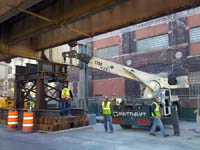
With the existing structure being called upon to support a new, modern station in addition to the tracks and track stringers, several columns and footings were replaced with more robust members. Looking southeast just east of Sangamon Street on November 9, 2010, the structure is supported by temporary shoring while the installation of the new column is completed. For a larger view, click here. (Photo by Tony
Coppoletta) |
Advance work at the site of the future station began in spring 2010, including the relocation of a water main. Preliminary work on the station itself began in Summer 2010. This work largely consisted of surveying, utility work, and tie replacement at the future station site.
Ground was broken for the new Morgan station on August 26, 2010. At the news conference, attended by Chicago Mayor Richard M. Daley, CTA President Richard L. Rodriguez, and other officials, Daley said construction of the station would provide 250 construction-related jobs, and cited the City's and CTA's commitment of funds to build the new station -- the first new stop added to the "L" system in nearly 10 years -- as an example of their commitment to continued capital investment in the mass transit system.
By mid-January 2011, underground work for the new station was almost done and above-ground work was ready to commence. After several months spent relocating utilities and reinforcing support columns for the Lake Street "L", CDOT was ready to start putting up pieces of the new station above ground in summer. At the time, the project about 10 percent complete and was on schedule.13
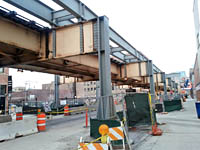
The new station is starting to take shape, with platform stringers beginning to be installed on the cross members supported by new, stronger columns, looking east between Morgan and Sangamon on March 18, 2011. For a larger view, click here. (Photo by Tony
Coppoletta) |
The early stages of work hadn't come without bumps in the road, however. For instance, crews found a few surprises underground, including an original brick sewer line from the 1800s. Such issues did not delay the project, though. "Any time we do underground utility work, built into the schedule is the opportunity to deal with unforeseen circumstances," CDOT spokesman Brian Steele said at the time.14
Once crews finished reinforcing the beams supporting the existing elevated track structure, they started moving forward on above-ground construction of the station. Starting mid-summer 2011, scaffolding started to go up next to the tracks. At that point, crews began building the foundation for the station's footprint, then begin vertical construction. 15
During late March, contractors began lifting the steel for the platform stringers into place, first on the inbound side, then the outbound. In mid-April, the elevator towers, which were pre-assembled, were lifted into place and secured.
The transfer bridge over the tracks, between the elevator towers, was set in place in mid-May. Precast concrete platform decking panels began to be installed in early June and were largely completed by July, except for a small portion in the middle of the station.
During summer 2011, additional station steel was set, including the frames for the large towering enclosures that would enclose the elevators and stairs between the street-level station houses and platforms, and between the platforms and the transfer bridge. By July, the concrete foundations for the street-level station houses were in place and installation of steel for the enclosures was underway. The first steel columns for the platform canopies were also installed by mid-July.
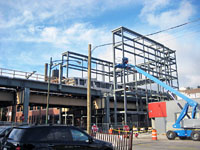
By this July 13, 2011 view looking northeast, the steel framework for the towers and transfer bridge was erected with installation of the platform canopy support beginning. For a larger view, click here. (Photo by Graham Garfield) |
During in late summer and early autumn work included painting the structural steel and the installation of additional steel members along the platform under the canopy. The stairs inside each station house to the platform, and between the platforms and the transfer bridge, were pre-fabricated off-site and installed at the station. Inside the station houses, conduits and other systems were installed, while outside the glass curtain walls enclosing the spaces began to be installed. Toward the end of this period, railing installation began on both platforms.
With the structural elements largely complete, work on the new Morgan station focused largely on the installation of systems and finishes during late 2011 and early 2012. The glazing installation on the south station house was completed during the month of October, and installed on the north station house during October through mid-November. Plumbing work in the south station house and platform continued throughout October, and in mid-October the transfer bridge concrete deck was formed and poured and stair to the north platform installed. Installation of the translucent roofing system on the transfer bridge began at end of December and continued through mid-January.
Painting of the structural steel continued through mid-November, while prepping and painting of the steel bents was ongoing through early January.
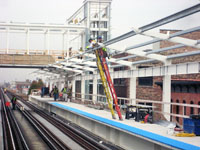
Work is underway on numerous parts of the Morgan station on this November 7, 2011 view, as two workers on ladders work on the outbound platform canopy structure. For a larger view, click here. (Photo by Graham Garfield) |
Platform work was performed through this period, with translucent canopy panels and gutters on the canopies being installed during October through early November. Installation of power and communications systems on the platforms was undertaken from mid-October into December. The blue tactile edging along the platforms was installed during early- through mid-November, while guardrail panels along the platform were installed from mid-November into December. The auxiliary exit stair at Sangamon Street from the south platform, and its associated roofing system, was installed during the first week of November, while the auxiliary exit stair from the north platform was installed a short time later. The exit rotogates at he auxiliary stairs were installed in late November. The windbreaks on the platforms were installed during late November through late January. The translucent roofing system on both platforms' canopies was completed during January.
Elevator framing was installed during October through early November. Installation of the north and south elevators began in late December and continued into at least February.
Work on both station houses also progressed, with the translucent canopy panels and gutters installed on south station house during mid- through late-November, and on the north station house during late November and into December. Work to install the Customer Assistant kiosk in the south station house began in late November. Installation of the granite flooring in the north station house began in late November and continued through early January, while installation of the translucent roofing system at that location occurred in mid- to late December. Installation of the granite flooring at the south station house began in mid-January 2012.
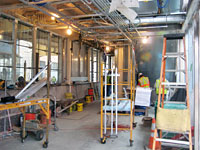
During late winter and spring, work was underway to install finishes and fixtures inside the Morgan station houses, including light fixture supports, light fixtures, communications and PA systems, and wall and ceiling panels. This view looking east inside the inbound station house on February 7, 2012. For a larger view, click here. (Photo by Graham Garfield) |
With major structural work and most platform canopy assembly completed by the beginning of 2012, late winter and spring were spent installing finishes and fixtures throughout the Morgan station facility. Work was undertaken to install light fixture supports, light fixtures, and communications and PA systems. During winter, installation of granite flooring in the station houses was completed and work to install the ceiling grid was carried out in late January and February. Installation of the ceiling panels in the station houses was completed in late April.
Guardrails were installed throughout the station in early 2012, with the railings installed at the Sangamon exit stairs in January and in the stairs between the station houses and platforms in January and February. Installation of the railings on the platforms continued into April, including the installation of the grilles in the railings which feature patterns cut out of the metal panels. Installation of windbreaks on the platforms continued through late April. The final translucent roofing panels were installed at the far ends of the platform canopies in late April.
By spring, work largely concentrated on final fixtures and elements. Installation of signage throughout the station was largely performed in April and was completed in early May. The exit rotogates at Sangamon auxiliary exits were installed in late April. Artist-designed bike racks were installed outside the station houses on the public way sidewalks near the station entrances during the first week of May, as were benches, landscaping, and pigeon control elements within the station. The fare control equipment was installed during the last weekend of April.
Morgan station opened at 4:20am Friday morning, May 18, 2012. The new stop increased the number of "L" stations on the system from 144 to 145 and became the 95th of the CTA's stations to become accessible. In addition to the accessible station houses described above in the Station Design section, other ADA-compliant features include tactile platform edging, gap fillers, and Braille signs.
Morgan station was officially dedicated on Thursday morning, May 24, 2012, at an event at the station attended by Chicago Mayor Rahm Emanuel, CTA President Forrest Claypool, CDOT Commissioner Gabe Klein, and 27th Ward Alderman Walter Burnett Jr.
Since the opening of the Morgan station in 2012, the number of business licenses and construction permits issued doubled in the first year, while weekday ridership increased by more than 40 percent within the first full year of operation. Google recently relocated near the station, numerous restaurants and shops have opened, and residential development has continued at a rapid pace.
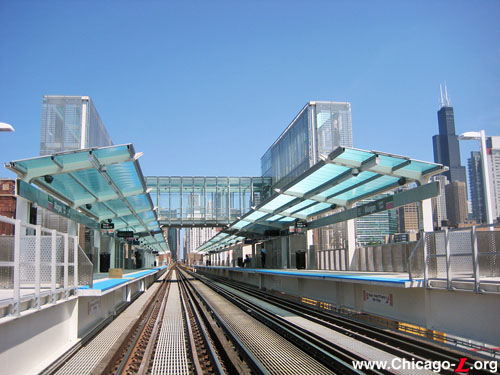
The Morgan station provides a silhouette to rival that of the skyline behind it, seen looking east on opening day, May 18, 2012. The station is distinctive with its tall perforated metal-clad twin towers, glass-enclosed transfer bridge, and green-tinted translucent canopy roofing. For a larger view, click here. (Photo by Graham Garfield) |

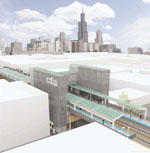 |
morgan-lake-rendering03.jpg (158k)
This artist's rendering of the Morgan station from an aerial view shows the overall massing of the facility, the height of the towers, and the design of the tower sheathing and platform canopies. (Rendering courtesy of CDOT) |
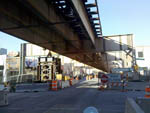
|
morgan-lake03.jpg (133k)
Temporary shoring and supports on the "L" structure resulted in lane closures on Lake Street while crews replaced the vertical support columns in the station area with new beams to support the station structure. In this view looking west on Lake at Sangamon on November 9, 2010, the column on the right is original while the one on the left has been replaced. (Photo by Tony Coppoletta) |
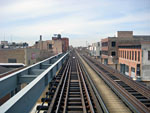 |
morgan-lake06.jpg (209k)
Several spans of stringers have been installed for the inbound platform in this March 31, 2011 view looking west, while the mounting supports for the installation of stringers for the outbound platform are already in place on the tops of the bent crossbeams outbound of the tracks on the right. (Photo by Graham Garfield) |
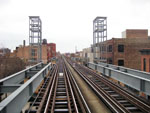 |
morgan-lake07.jpg (209k)
The basic elements of the new Morgan station are coming together in this view looking west on April 20, 2011, with stringers for both platforms installed (with the gap in the stringers where the future stairs to the street-level entrances and to the transfer bridge will be) and the pre-fabricated elevator tower frames lifted into place. (Photo by Graham Garfield) |
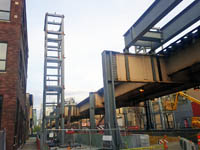 |
morgan-lake08.jpg (166k)
The steel framing for the elevator towers has begun to the erected in this view looking east on May 6, 2011, as well as some of the steel platform stringers. Rebar is in place for the concrete station house base to be poured inside of the concrete protective wall. (Photo by Tony Coppoletta) |
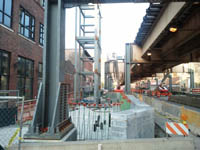 |
morgan-lake09.jpg (188k)
The location of the future outbound station house is seen looking east on the northeast corner of Lake and Morgan on May 6, 2011. The concrete protective wall along the street is already in place. Note the elevated structure column that was moved into the former street right-of-way from the sidewalk to accommodate the new elevator tower. (Photo by Tony Coppoletta) |
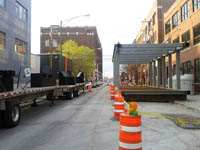 |
morgan-lake10.jpg (168k)
The prefabricated steel frame for the transfer bridge over the tracks, between the platforms, sits on Morgan Street north of Lake Street awaiting being lifted into place on May 6, 2011. (Photo by Tony Coppoletta) |
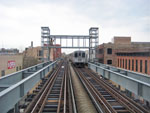 |
morgan-lake11.jpg (208k)
A Pink Line train on its way to 54th/Cermak passes underneath the recently-installed steel framework for the transfer bridge between the two platforms at Morgan on May 9, 2011. Workers on a cherry picker work on the recently-raised steelwork. (Photo by Graham Garfield) |
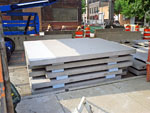 |
morgan-lake12.jpg (227k)
Precast concrete platform panels sit in stacks along Lake Street waiting to be installed on the Morgan platform steel stringers on June 3, 2011. (Photo by Tony Coppoletta) |
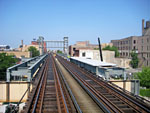 |
morgan-lake13.jpg (242k)
Precast concrete panels begin to be installed at Morgan, starting at the east end of the outbound platform, looking west on June 7, 2011, beginning to form the new station's platform decks. The panels are lifted from the street to track level by the crane on the right. (Photo by Graham Garfield) |
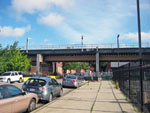 |
morgan-lake14.jpg (215k)
Looking south on Sangamon Street on July 13, 2011, the new Morgan station is starting to take shape. The platform stringers and deck are in place on the outbound platform, and the steel supports for the platform canopy have begun to be installed. A temporary wooden back railing has been installed for the safety of workers on the platform. (Photo by Graham Garfield) |
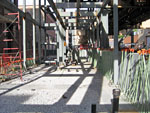 |
morgan-lake15.jpg (301k)
The site of the future outbound station house has been roughed in in the bottom of the north tower, looking east on July 13, 2011. Pipes and conduit for various electrical, communications, and other systems installed when the foundation was set are sticking up from the rough gravel base on which the floor will be set, while rebar sticks up around the edges where low concrete walls will eventually be poured. (Photo by Graham Garfield) |
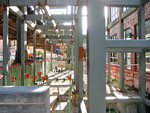 |
morgan-lake16.jpg (334k)
This view looks west through the steel framework for the north tower at Morgan station into what will eventually be the outbound station house on July 13, 2011. The elevator to the platform will be where the pit on the bottom right is located. (Photo by Graham Garfield) |
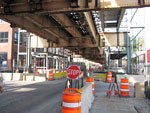 |
morgan-lake17.jpg (255k)
Looking east on Lake Street on July 13, 2011, the bases of the Morgan station's two towers are seen on either side of the elevated structure. The street level of the two steel frameworks will house the station's entrances and fare control areas. (Photo by Graham Garfield) |
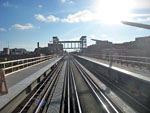 |
morgan-lake19.jpg (198k)
The afternoon sun is shining on the under-construction Morgan station, looking west on July 13, 2011. The steel frame of the twin towers and transfer bridge are visible in the distance, and nearly all of the precast concrete platform deck has been installed except for a portion near the towers. The supports for the canopy have been installed on the outbound platform; the ones on the inbound platform will be erected next. (Photo by Graham Garfield) |
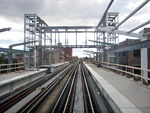 |
morgan-lake20.jpg (217k)
Work is progressing at platform level at the new Morgan station, looking west on September 5, 2011. The main support columns for the canopies have been installed on both platforms, as have the horizontal support for the raceway along the back that will carry conduit and signage. Purlins to carry the roofing have begun to be installed on the outbound canopy on the right. Work has also started on painting all the steelwork. (Photo by Graham Garfield) |
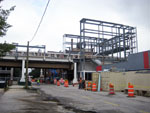 |
morgan-lake21.jpg (214k)
A Pink Line train passes through the skeleton of the new Morgan station, seen under construction looking north at street level on September 9, 2011. Most of the steel framework is in place and painting of the structure has begun. A pre-assembled stairway between street level and the inbound platform has been lifted into place. (Photo by Graham Garfield) |
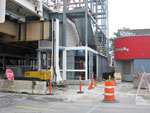 |
morgan-lake22.jpg (255k)
Conduit and other systems are being roughed in and installed in the south tower at Morgan station, whose bottom level will house the inbound entrance and fare controls, seen looking east on September 9, 2011. The bottom pre-assembled stairway flight, between the street level entrance and the platform, has been installed. The cinderblock enclosure at the intermediate level will house equipment rooms and other ancillary systems. (Photo by Graham Garfield) |
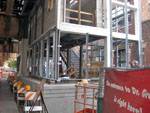 |
morgan-lake23.jpg (232k)
The bottom level of the north tower, which will house the outbound station entrance at Morgan station, is seen looking west on September 9, 2011. The stairway to the platform is visible inside. The clip system that will hold the glass panels of the exterior curtain wall system is in place on the mullions around the exterior. The cast concrete base not only serves an aesthetic function, but will also be a crash barrier for any wayward vehicles that might hit the station house, which is immediately adjacent to the street. (Photo by Graham Garfield) |
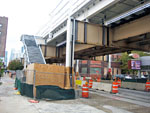 |
morgan-lake24.jpg (234k)
The east end of the Morgan station is seen under construction looking east on Lake Street at Sangamon Street on September 9, 2011. The auxiliary exit stairway -- installed already pre-assembled -- is in place from the outbound platform; the matching stair from the inbound platform across the street has not been installed yet. (Photo by Graham Garfield) |
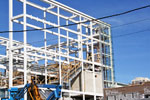 |
morgan-lake25.jpg (262k)
A construction worker uses a roller on a long extension handle to paint the steel structure of the new Morgan station under construction, looking northeast on November 4, 2011. Progress is being made in other areas of the station as well -- the stairway from the inbound platform to the transfer bridge has been installed, and the glass curtain wall has begin to be installed at the east end of the south tower. (Photo by Graham Garfield) |
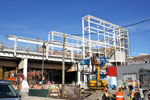 |
morgan-lake26.jpg (252k)
The new Morgan station is seen under construction, looking northeast on November 4, 2011. Painting of the steel structure is all but complete and the glass panels of the exterior curtain wall system have begin to be installed on the towers. (Photo by Graham Garfield) |
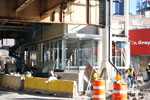 |
morgan-lake27.jpg (250k)
The station house in the bottom of the south tower, on the inbound side of the station, is beginning to be enclosed with the glass panels of the exterior curtain wall system in this view looking east on November 4, 2011. (Photo by Graham Garfield) |
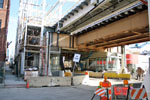 |
morgan-lake28.jpg (263k)
Work is underway in both street-level station houses, each in the base of the twin towers at the Morgan station -- the outbound entrance in the north tower on the left, the inbound entrance in the south tower on the right -- in this view looking east at the corner of Lake and Morgan streets on November 4, 2011. Systems are being installed inside while the glass curtain walls are being installed on the exterior elevations. (Photo by Graham Garfield) |
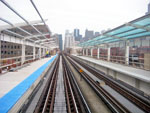 |
morgan-lake29.jpg (256k)
Work is progressing at platform level at the new Morgan station, looking east on November 7, 2011. The steel cantilevered supports and purlin system to support the roofs have been installed for the canopies on both platforms. Other work is advancing on each platform -- the sage-green-tinted translucent polycarbonate roof panels have begin to be installed on the inbound canopy on the right, while the blue tactile edging tiles have started to be installed on the outbound platform on the left. (Photo by Graham Garfield) |
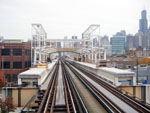 |
morgan-lake30.jpg (255k)
Framed by the downtown skyline in the background, the Morgan station is seen under construction looking east from the west end of the station on November 7, 2011. With all of the structural elements in place, work is underway on installing basic components like roofing, wall panels, and operational systems. (Photo by Graham Garfield) |
 |
morgan-lake32.jpg (219k)
On a rainy December 22, 2011, the construction of the new Morgan station is seen underway. Tactile edging tiles and translucent polycarbonate canopy roof panels are being installed on both platforms, while glass curtain wall panels can be seen on both towers in the distance and framing for the curtain walls on the transfer bridge can also be seen in evidence. (Photo by Graham Garfield) |
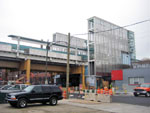 |
morgan-lake33.jpg (192k)
Finishes and decorative metalwork, such as the decorative perforated steel panels on the two towers and the panels on the platform railings, are well along being installed on the new Morgan station, looking northeast on February 7, 2012. (Photo by Graham Garfield) |
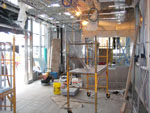 |
morgan-lake34.jpg (257k)
The granite flooring and stainless steel Customer Assistant's booth are in place while wiring and conduit continue to be installed inside the inbound station house, looking west on February 7, 2012. (Photo by Graham Garfield) |
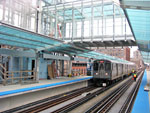 |
morgan-lake36.jpg (265k)
A 54th-bound Pink Line train slowly passes through as work on the new Morgan station continues in this view looking east on February 7, 2012. The glass wall panels and polycarbonate canopy roofing have been installed, and wiring is being pulled through the raceway along the underside of the platform canopies. Work on both core systems and finishes continues. (Photo by Graham Garfield) |
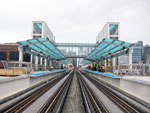 |
morgan-lake37.jpg (247k)
The new Morgan station is beginning to take on a look closer to its final form as construction continues, looking east February 7, 2012. The platform railings and the decorative perforated steel panels on the west elevations of the two towers are two of the last major aesthetic elements missing, besides all the smaller fixtures and appointments. (Photo by Graham Garfield) |
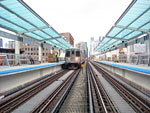 |
morgan-lake38.jpg (266k)
A construction worker stands back as a Harlem-bound Green Line train passes through the Morgan station work site, looking east on February 7, 2012. Save for the railings still to be installed, the platforms are beginning to take on their final form. Rectangular panels that will be used to assemble the windbreaks are leaning against the temporary back railings on both platforms. (Photo by Graham Garfield) |
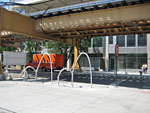 |
morgan-lake39.jpg (234k)
As part of the project, special decorative, ornamental bike racks -- in a variety of artistic shapes and designs -- were installed on the street around the Morgan station entrances. These were installed on Lake Street west of Morgan, across the street from the station entrances, seen looking north on May 18, 2012, the day the station opened. (Photo by Graham Garfield) |
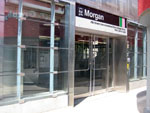 |
morgan-lake41.jpg (197k)
The Morgan station entrance in the base of the south tower, leading to the inbound station platform, is seen on opening day, May 18, 2012, looking northeast. The street level of the tower is enclosed in a glass panel curtain wall, providing maximum visibility for an open feeling and for security, with a stainless steel portal containing the doors. Above, the tower is clad in perforated steel panels. (Photo by Graham Garfield) |
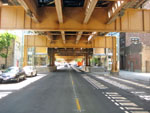 |
morgan-lake42.jpg (226k)
The twin Morgan station houses in base of the station's towers are seen looking west on Lake Street on May 18, 2012. Enclosed in glass panels, the entrances are immediately adjacent to the roadway the base of the structures has a high concrete wall to provide collision protection. The elevated track structure was repainted as part of the project. Decorative bike racks can be seen on the right behind the station building. (Photo by Graham Garfield) |
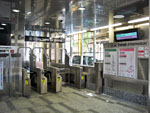 |
morgan-lake43.jpg (242k)
The interior of the north station entrance is seen looking southeast in the unpaid area on May 18, 2012, opening day. The interiors of the entrances are very compact with little space for amenities, but they do include a Transit Information panel and a train arrival display. Although this entrance leads directly to the outbound platform, customers can access the inbound platform via the transfer bridges so train arrivals for both directions are provided. (Photo by Graham Garfield) |
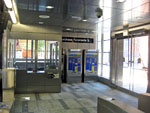 |
morgan-lake44.jpg (202k)
The interior of the north station house is seen looking west from the turnstiles on opening day, May 18, 2012. The interior space is minimal, with just enough room for circulation between the doors and turnstiles, short queues in front of the farecard vending machines, and a Customer Assistant booth, which takes up a sizable amount of the unpaid area floor space. The booth on this side is not regularly staffed, with the single CA typically assigned to the station positioned in the other station house. In early drafts of the station designs, this booth was considered to be used for a concession space. (Photo by Graham Garfield) |
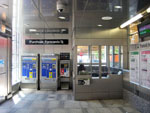 |
morgan-lake46.jpg (220k)
The modest-size interior of the south Morgan station house is just big enough for the modest amenities it houses: a Customer Assistant kiosk, three farecard vending machines including a credit/debit card Express Vending Machine (all three later replaced by Ventra vending machines), a Transit Information panel with timetable posters and maps, and a train arrival digital screen. Seen looking west from the turnstiles on May 18, 2012, opening day, the granite flooring, glass curtain walls, and stainless steel wall and ceiling panels befit the station's modern design aesthetic. (Photo by Graham Garfield) |
 |
morgan-lake47.jpg (182k)
After passing through the turnstiles in each station house, a short corridor leads to the stairs to the platform and the elevator to the platform and transfer bridge. The elevator is tucked behind the stairs, so an illuminated sign helps to identify it. This view looking east on May 18, 2012 shows the paid area corridor and stairs in the south station house, which leads to the inbound platform. (Photo by Graham Garfield) |
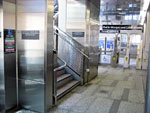 |
morgan-lake48.jpg (208k)
This view looking west inside the south Morgan station house on May 18, 2012 provides a view of the interior from the far east end of the station house, with the elevator just out of view on the left, stairs to the inbound platform on the left, and the turnstiles and unpaid area visible in the background. The perforated steel panels on the stairs continue a motif from the exterior panels on the station towers. (Photo by Graham Garfield) |
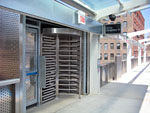 |
morgan-lake50.jpg (214k)
Both Morgan station platforms include auxiliary exits at their east ends that lead down to Sangamon Street, one block east of Morgan Street. The exits are equipped with exit-only rotogates and emergency exit doors; the perforated steel paneling used on the railing is extended up to full height to prevent fare evaders from climbing around the rotogate. The auxiliary exit on the outbound platform is seen looking east on May 18, 2012. (Photo by Graham Garfield) |
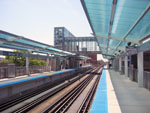 |
morgan-lake51.jpg (235k)
The Morgan station platforms are seen looking west from the outbound platform on opening day, May 18, 2012. The station projects a modern design, with its green-tinted translucent polycarbonate canopy roofs, glass-enclosed transfer bridge and perforated steel railing panels. Signage was designed to the integrated into the structure, utilizing the columns and conduit raceway to minimize extra mounting frames and supports. (Photo by Graham Garfield) |
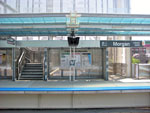 |
morgan-lake53.jpg (223k)
The inbound platform is seen looking south from the outbound platform on May 18, 2012. The stairs on the right lead down to the station house at street level, while the stairs on the left lead up to the transfer bridge. In between is a recessed area that doubles as a windbreak and the location of the Transit Information Panel containing the maps and timetables. The outbound platform has the same setup, just mirrored. (Photo by Graham Garfield) |
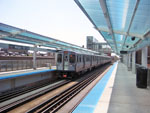 |
morgan-lake55.jpg (236k)
A Loop-bound Pink Line train stops at Morgan station on opening day, looking west on May 18, 2012. (Photo by Graham Garfield) |
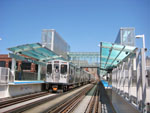 |
morgan-lake56.jpg (226k)
Morgan station's impressive silhouette is demonstrated in this trackside view looking east from the west end of the station on its opening day, May 18, 2012. A Pink Line train is stopping at the station on its way to 54th/Cermak. The cameraman on the left is shooting B-roll of the new station for the CTA. (Photo by Graham Garfield) |
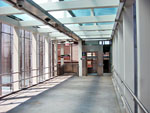 |
morgan-lake57.jpg (190k)
The interior of the Morgan station transfer bridge is seen on May 18, 2012, looking north. The floor-to-ceiling glass wall panels bathe the bridge interior in light on sunny days. The stairs and elevator head lead down to the outbound platform -- Harlem-bound Green Line service and Pink Line trains to 54th/Cermak. In an effort to minimize clutter and maintain a streamlined appearance, the lighting and security cameras are integrated into the station's structural elements and paneling. (Photo by Graham Garfield) |
 |
morgan-lake58.jpg (228k)
The auxiliary exit stair from the outbound platform down to Sangamon and Lake streets is seen looking east on May 18, 2012, the station's opening day. The perforated steel paneling on the sides of the stairs match those on the platform railings and elsewhere in the station. The concrete-filled steel bollard posts in front of the stairs protect them -- and passengers -- in case of a wayward vehicle jumping the curb. (Photo by Graham Garfield) |
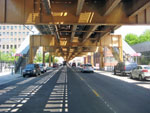 |
morgan-lake59.jpg (246k)
This view looking east on Lake Street under the elevated track structure at the east end of the Morgan station shows the auxiliary exit stairs from both platform descending to each side of the street just west of Sangamon Street on May 18, 2012. (Photo by Graham Garfield) |
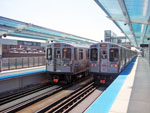 |
cta5056_5058.jpg (245k)
Chicago's newest cars at its newest "L" station: A pair of Pink Line 5000s -- car 5056 leading a Loop-bound train and car 5058 trailing a 54th-bound train -- meet at the new Morgan station, looking west on May 18, 2012, Morgan's opening day. (Photo by Graham Garfield) |

Notes:
1. Maidenber, Micah. "A Green Line station at Morgan", Chicago Journal, 3 December 2008.
2. Mayor Daley Reiterates City's Committment To Investing In Transit Infrastructure, City of Chicago press release, August 25, 2010.
3. Maidenberg, ibid.
4. Ross Barney Architects, Inc. "CTA Morgan Street Station." Accessed 29 April 2012.
5. Kamin, Blair (2012). "Gleaming new CTA station raises question: What price architecture?" Chicago Tribune, May 29, 2012.
6. Kamin (2012), ibid.
7. Kamin (2012), ibid.
8. Ross Barney Architects, ibid.
9. Marketwire, Marketwire.com. "Translucent Canopies by Duo-Gard Elevate CTA's New Morgan Street Station." Posted 01/30/2013, Accessed 1/31/13.
10. Marketwire, ibid.
11. Marketwire, ibid.
12. Kamin, Blair. "Rush, CTA, Roosevelt among honorees for building design." Chicago Tribune, October 25, 2013.
13. Meyerson, Ben. "Morgan Station chugging along." Chicago Journal, January 19, 2011.
14. Meyerson, ibid.
15. Meyerson, ibid.

































































